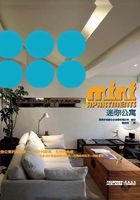
FUNCTION BOX
机能盒


设计师:邵唯晏
设计单位:竹工凡木建筑室内设计研究室(CHU-Studio)
项目地点:中国台湾台北市
建筑面积:46.2平方米
主要材料:钢构、木作、抛光石英砖、强化玻璃、压克力、冷烤漆、碳化木等
The core concept of the case is “Function Box”. The designer installed a long approaches high ceiling path and three sidelong boxes into the house. Through the path, the whole space is not only linked but ventilated and brightened;through the three boxes, The designer made the most of the limited space.
The first “box” is to make the best use of the space. By placing a “box” at the junction between lower ceiling and higher ceiling, The designer integrated all major functions here, such as three air conditioners, refrigerators, closet, TV, electric equipments cabinet, storage cabinet, and etc. It is also like partitions that separate the master room and the guest room. The idea of integration is to make full use of vertical height and horizontal space. When the function of storage is enhanced and the objects in the space are simplified, large numbers of curves that The designer used become eye-catching. These curves also create a sense of harmony since the angles were much less now, and make the space look more spacious.The second “box” is in the front of the house. It integrates the functions of a kitchen, a dining table and a bar specially requested by the house owners. Meanwhile, The designer also replaced the front ceiling and front wall with panoramic windows and mountain scenery, making dining time a real treat for the couple. Now, this area of not more than 7 square meter has become the house owners' favorite space. The third “box” is in the back of the house. To utilize more space and break the rules of ordinary bathrooms, The designer used sliding interfaces in the bathroom. When sliding doors are opened, the whole chic bathroom, except the toilet, becomes a part of the interior, and all spaces of the house get connected. Bathroom is no longer a bathroom only.



本案的核心理念是“Function Box”,设计师在空间中置入一个长向的挑高走道及三个横向的盒子。前者是为了让空气流通及光线充足,透过一道长向的虚盒子贯穿、连接整个空间,让流动的空气及光线溢散整个空间。而后者则是企图借由这三个盒子,在面积狭小的现实条件下,争取最大化地利用空间。
第一个“盒子”主要是为了争取更大的空间。在中段高低交界处的死角置入一个“盒子”,借此整合所有重大机能,包含三台空调机、冰箱、衣橱、电视、电器柜及大型收纳柜等,同时也是客房与卧房的隔间墙。整合的用意是为了争取垂直高度及水平空间,让设备脱离天地壁,全部置入这个“机能盒”中。通过有效整合机能需求及简化空间物件,让空间中大量的曲线线条能尽情游走,同时,曲线的使用也增加空间的圆融感,减少棱棱角角处,进而产生空间放大的效果。第二个“盒子”在前段,也是为了争取空间,整合了厨房机能、餐桌需求及业主特别要求的BAR台,同时将前段空间的天壁打开,让每日的三餐与宵夜都有背后的景致相伴,让这个不到7平方米的空间成为业主每日必待的场所之一。第三个“盒子”在后段,同样是为了争取空间,采用多片滑动的界面,通过不同界面的闭合,令洗手台空间成为平日里室内空间的一部分。真正的厕所只定义在便所空间,打破“所有功能放在一间厕所”的既有思维。












